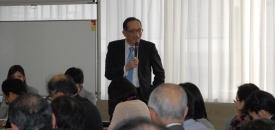WKC Forum on Kaigo yobo interventions: the state of the art and future challenges in Japan

What are the future challenges facing the elderly? One of the many key questions posed during a forum attended by more than 60 participants at Hyogo Women’s Exchange Hall in Kobe City on 21 March, 2012.
Under the theme “Kaigo yobo: present and future challenges” the invited audience from many different spheres of interest, including universities, NGOs and local government, met to critically explore Japan’s current approaches on disability prevention. Kaigo yobo is a Japanese term that encompasses the notion of disability prevention among the elderly.
The two hour forum was opened by Mr Alex Ross, Director of the WHO Kobe Centre (WKC), followed by a brief introduction on the work of WKC by its Technical Officer on Urban Health Metrics, Dr Megumi Kano.
Keynote address - evaluating kaigo yobo:
Delivering the key note address was Dr Ichiro Kai of Tokyo University Graduate School of Medicine. He stressed the need to evaluate kaigo yobo programmes - including cost-benefit analysis - to demonstrate their effectiveness and value. However, he told the audience that the programmes should not be considered solely a health intervention, but also a “welfare” intervention. This therefore required subjective outcome indicators (e.g. quality of life etc.), though he admitted there were obvious challenges associated with conducting rigorous evaluations of this kind, especially in the community. He did close his speech on a note of optimism, with a call for the development of evidence-based kaigo yobo guidelines that are based on such procedures.
Research presentations: i) systematic review ii) evaluation methods:
Dr Kanako Masuno, a PhD researcher at Tokyo University, shared the findings from a systematic literature review on the effectiveness of disability prevention programmes both in Japan and overseas.
She said that there is plenty of evidence for the effectiveness of kaigo yobo in improving the physical health of the elderly, especially in fall prevention, but the effect of these programmes on other areas, such as on oral health, nutrition, cognition, mental health and social well-being is not yet well established.
Dr Yumi Kimura, a PhD researcher at Kyoto University, presented on recommended methods for evaluating kaigo yobo programmes and, specifically, on the utility of the healthy life expectancy indicator for monitoring and evaluating public health interventions.
A recent effort to standardize an evaluation method for kaigo yobo programmes nationally, was outlined, as were case examples of municipalities that showed the impacts of kaigo yobo programmes on health outcomes and healthcare costs.
On healthy life expectancy, an overview of the different calculation methods and the advantages and disadvantages of the indicator was shared, backed by examples of its use around the world. The potential for its use in Japan was also discussed.
Dr Kimura also presented findings from her field work on kaigo yobo programmes in Japan. She noted that despite the challenges, Japan’s programme is one of the most progressive in the world. She concluded with her vision of healthy ageing in the community with kaigo yobo, based on a multi-disciplinary, holistic approach.
Audience discussion:
The evening ended with the audience encouraged to share their experiences on kaigo yobo. Among the valid concerns was the gap between the needs of technical researchers and the needs of government officials who administer kaigo yobo. It was suggested this could be bridged by the two groups working more closely and by researchers addressing in their work the issues related to programme implementation.
Discussions also took place on evaluation methods – as highlighted during the key note address – as well as the need for greater awareness on gender sensitivities, for example, disease prevention among men, and musculoskeletal strengthening among women.

